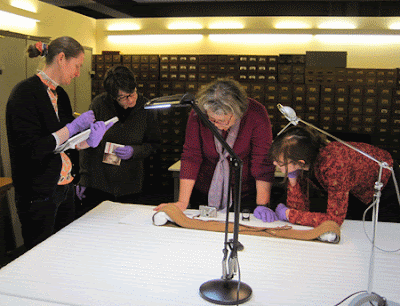'Last week we had a visiting researcher examine a number of Māori textile taonga, or treasures, in the Cook-voyage collections at the Pitt Rivers Museum. Formerly based in the Macmillan Brown Centre for Pacific Studies, Dr Patricia Te Arapo Wallace is a Teaching Research Fellow at the University of Canterbury in Christchurch, a Research Associate of Te Papa Tongarewa, Wellington, New Zealand, as well as being an Affiliated Researcher of the Artefacts of Encounter project. She was accompanied by Alice Christophe who is undertaking a two-month intern placement at the Museum of Archaeology and Anthropology, Cambridge, as part of the project.
Dr Wallace is particularly interested in Māori dress. She was examining objects in our collection with reference to drawings made of Māori during the Cook voyages and an earlier Abel Tasman voyage.
 |
| Examining tatua 1886.21.2 |
The visit began with an examination of a number of our tatua or belts. These belts were part of the collection of Joseph Banks who was the naturalist on Captain Cook’s Endeavour voyage of 1768 to 1771. The tatua 1886.21.2 has an extremely finely woven central panel that would have wrapped around the waist and would be fastened using the elaborately plaited cords at either end. Dr Wallace pointed out a detail from an image in Abel Tasman's 1642 Journal in which similar belts were depicted by Tasman's artist Isaac Gilsemans in the 17th century; they can also be seen in Sydney Parkinson's 18th century drawing of warriors aboard a waka (canoe).
 |
| Detail of a 1642 drawing from Tasman's journal showing warriors wearing belts or tatua |
Dr Wallace is also interested in early examples of Māori sewing. The tatua 1886.21.2 has been stitched using strips of hide while the kahu waero, or dog hair tassel cloak, 1886.21.19 that she has previously examined, has decorative elements stitched to the surface with thread extracted from harakeke (Phormium tenax - New Zealand flax). The kahu waero is also from the Joseph Banks’ collection. It has a finely woven kaupapa, or body of the cloak, that was once covered with clusters of awe, which are tassels made from the tail hair of prized white kurī, the Polynesian dog brought to New Zealand by Maori. Dr Wallace was keen to explore how these clusters were attached to the garment. The examination was enhanced with the use of a DinoLite™ a USB microscope from our conservation lab. This enables close examination of areas of particular interest, which can be digitally photographed.
 |
| Examination of the kurī hair tassels attached to 1886.21.19 |
The DinoLite™ showed clearly the varied techniques used to bind the kurī hair into tassels, an interesting observation which suggests that the clusters of awe were probably made by more than one person.
 |
| Detail of 1886.21.19 showing twisting and binding of kurī hair |
 |
| Detail of 1886.21.19 showing the stitching thread securing the tassels on the front surface piercing the kaupapa of the kahu waero on the inside of the garment. |
On this occasion Dr Wallace could only spend one day looking at these pieces - not long enough - but we hope she will be back soon.
Each researcher that examines these taonga brings their personal perspective and knowledge, which adds to the understanding of the object. In Dr Wallace’s case she is exploring the wearing and technology of these early textiles. Her research feeds into, and is supported by, the Māori weaving community as the technology itself is a taonga and these early artefacts show techniques not practiced by modern day weavers.
These objects have yet to be examined by Jeremy as part of his investigations into the Cook-Voyage collections at the Pitt Rivers. I am looking forward to what findings he will add, enriching further these precious taonga that can speak to us though their materials.'